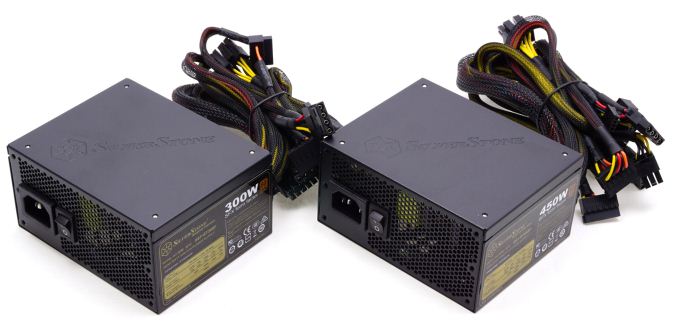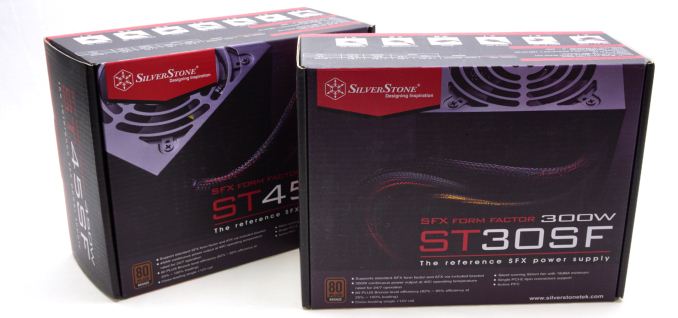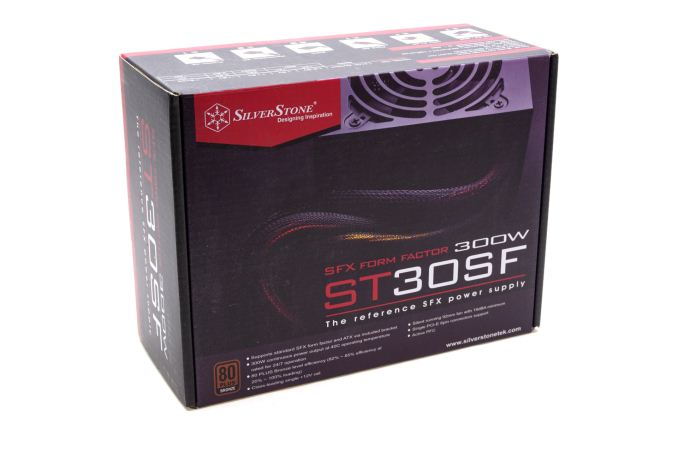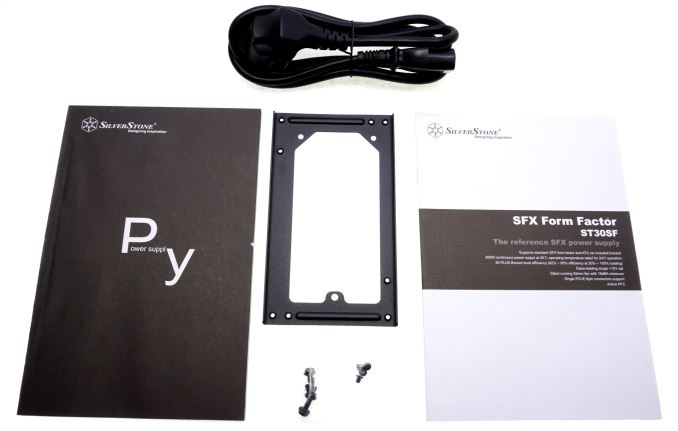The Silverstone ST30SF & ST45SF SFX Power Supply Review
by E. Fylladitakis on January 26, 2017 9:00 AM EST- Posted in
- Cases/Cooling/PSUs
- PSUs
- 80Plus Bronze
- SilverStone
- SFX
- ST30SF
- ST45SF

With the vast selection of advanced ATX PSUs available today, PC users can easily pick one that perfectly suits their budget and needs. When shopping for an SFX PSU however, the options are very limited, as very few companies do market advanced high quality SFX PSUs. Even when the company has a few SFX units available, most of the time these are expensive top-tier models, leaving budget-driven users bewildered.
One of the companies that invests a lot on small form factor systems is SilverStone. The company currently markets dozens of proprietary PC cases, many of which require SFX PSUs. SilverStone is also marketing some of the most advanced SFX PSUs available, such as the 700W SX700-LPT that we reviewed a few months ago and their newly released 800W SX800-LTI with 80Plus Titanium compliance. Outrageously powerful (and expensive) SFX PSUs are not useful to users that want to build simple, compact media or office PCs. Their “SFX extended” form factors make them incompatible with very compact case designs anyway, including many of SilverStone’s own products.
Today we are having a look at the two SFX units that SilverStone is offering for budget-conscious builders, the ST30SF and the ST45SF. Although they are not as grand as the top-tier PSUs we mentioned before, they do have a high power output of 300W and 450W respectively, sufficient for typical media and gaming PCs. They only have an 80Plus Bronze efficiency certification, but what they lack in technology they make up for in price. We should clarify that the units in this review are the latest version, V2.0 for the ST30SF and the V3.0 for the ST45SF, that have been reengineered for improved performance in home and gaming PCs. Most of the differences over their previous versions will be highlighted in the following pages, but the first difference that we should point out is that the new units are rated at 40°C ambient temperature, whereas the previous versions were rated at 50°C.
| SilverStone ST30SF Power specifications ( Rated @ 40 °C ) | |||||
| AC INPUT | 100 - 240 VAC, 50 - 60 Hz | ||||
| RAIL | +3.3V | +5V | +12V | +5Vsb | -12V |
| MAX OUTPUT | 16A | 16A | 25A | 3A | 0.3A |
| 90W | 300W | 15W | 3.6W | ||
| TOTAL | 300W | ||||
| SilverStone ST45SF Power specifications ( Rated @ 40 °C ) | |||||
| AC INPUT | 100 - 240 VAC, 50 - 60 Hz | ||||
| RAIL | +3.3V | +5V | +12V | +5Vsb | -12V |
| MAX OUTPUT | 20A | 20A | 37.5A | 3A | 0.3A |
| 110W | 450W | 15W | 3.6W | ||
| TOTAL | 450W | ||||
Packaging & Bundle
SilverStone supplies their cost-effective SFX PSUs in aesthetically simple, practical cardboard boxes. The artwork on the black boxes is minimal, but SilverStone had every worthwhile bit of information printed on them and they should provide ample shipping protection to the lightweight units.
We expected to find only the absolute minimum of items bundled alongside such units but SilverStone had us surprised. Except from the thorough manual, black mounting screws and the necessary AC cable, the company also supplies an ATX to SFX adapter frame, allowing these SFX units to be installed into ATX compatible cases. This greatly enhances the value of the units, ensuring that they may fit into other cases into the future, as well as their potential market group, as they may be appealing to modders and other people that wish to save some space in their PSU compartment for some reason.
| Connector type | SilverStone ST30SF | SilverStone ST45SF |
| ATX 24 Pin | 1 | 1 |
| EPS 4+4 Pin | 1 | 1 |
| EPS 8 Pin | - | - |
| PCI-E 6+2 Pin | - | 1 |
| PCI-E 6 Pin | 1 | 1 |
| SATA | 3 | 3 |
| Molex | 2 | 2 |
| Floppy | 1 | 1 |













30 Comments
View All Comments
wolfemane - Thursday, January 26, 2017 - link
We are at a good point in power consumption where 550w and up aren't needed for standard builds. I'm running an i5-6600k oc'ed to 4.5ghz paired with a gtx 1080 on an asus mitx pro gaming board. M.2 os drive, couple mid range ssds for storage, and your basic 16gb ddr4-3200. At the wall, under load I'm barely drawing 400w. Currently using the 450w that comes with the Node 202.takeship - Friday, January 27, 2017 - link
Second to this. I purchased one of these Silverstone 450's a whopping 3y ago (v2 at the time) for a mITX Haswell i5 build with a GTX 660 (ncase m1). At load the system never topped 350w (according to HWMonitor), but it was more than enough (esp with the 80cm fan) and left a good bit of room to upgrade to something newer in the future. 8pin PCIe connectors are amazing for future proofing.takeship - Friday, January 27, 2017 - link
Still running without issue as well, for whatever the data value of my own anecdote is.NZLion - Tuesday, January 31, 2017 - link
The system I have running on a 600W SFX PSU is an ITX box with i7 6850K, 32GB DDR4 3000, Titan X Pascal, and 2TB Samsung 960 Pro M.2I haven't measured the load at the wall, but according to an online calculator (Outervision) I am likely using about 520W
zodiacfml - Friday, January 27, 2017 - link
300W is plenty these days. Thanks for the review. I am interested in such PSUs. I miss building PCs again, but now, I want the challenge of compact ones.Zan Lynx - Sunday, January 29, 2017 - link
That entirely depends on what you are building. A top end Intel CPU at full load can burn 140W plus the motherboard at 30W. Add a high end GPU at full load for 250W and you're at 420W already. Spinning hard drives idle at about 5W but during power-up they use up to 35W to spin up. There's been many a home-server builder with a broken build because their 8 drive system didn't have enough watts. NVMe SSDs use a lot of power during writes, the Intel models use up to 30W.Ascaris - Saturday, January 28, 2017 - link
I considered PSU reviews very carefully before I bought my current one. I find them extremely useful!thomasg - Sunday, January 29, 2017 - link
I, too, do appreciate such reviews, as they are actually useful for me a lot of times.Others should consider, that they might me more useful to them than they think, because more often than not such PSUs are much more suitable to most builds than the high-end stuff people seem to think they want.
There clearly is a need for good low-powered PSUs for smaller builds, and there really is a heavy lack of such units.
Just 2 weeks ago a friend asked me for a recommendation for a small media-server build for a couple of hard-disks in a small case, and I really had a hard time recommending anything with a practical power envelope.
It's really absurd that people think the widely available oversized PSUs are ever useful, as there is only a tiny tiny fraction of builds that can utilize them to more than 50% load.
A 600W PSU in a small SFX case seems ridiculous, as it is extremely unlikely that anyone will be using a >100W CPU and more than one 300W GPUs in those.
In this high-end setup even with reserves and some hard-disks you won't ever utilize more than 500W on the 12V rails. A 600W PSU will typically provide at least 550W on the 12V rails.
My rule of thumb for builds is to reach 80% load on 12V for hardware you're actually going to use, and if possible 20% load at typical low-power use (achieving 20% on idle would be ideal, but is impractical).
My dated Phenom II X6 setup is using a 550W GPU.
This is the X6 running at 4 GHz with slight voltage increase (max. 150W), a HD7970 (max. 300W), Chipset 15W, Storage 30W, 3 180mm fans (15W). Combined max. 510W.
Considering some of the power draw is not on the 12V rails, a PSU with 550W on 12V is plenty with some reserves.
This is an old platform with very high-draw components, that just aren't typical anymore.
So let's see what we can do with a 300W SFX PSU (obviously this will be no ultra-high-end overclocking system, that's simply not the purpose):
i5 65W, GTX 1070 150W, SSD+2*2,5" disks 20W, Chipset+RAM+Controllers 30W = 265W.
The 300W PSU can handle this easily with reserves.
Anyway, thanks for the review, I'm sure I will take these units into consideration for upcoming builds.
none12345 - Monday, January 30, 2017 - link
I wouldnt load a 450 watt power supply with 400 watt, 90% load will havea pretty short service life. Assuming you game a lot. Personally i shoot for ~80% load on electronics, it seems to make them last a hell of a lot longer. As well as power supplies being more efficient at ~80% load then ~90%.If i knew i would have a 400 watt load when gaming i would buy either a 500, or 550 watt, depending on price/specs. a 650 is too big, a 450 is too small in my opinion. You already have an approiately sized ps for that load.
thomasg - Wednesday, February 1, 2017 - link
As I said, 80% is the number to go for, we're not disagreeing.However, I'd argue, that you shouldn't be too conservative with your reserves, as actual usage will almost always be lower than the theoretical maximum.
Even with games using your hardware to the fullest extent, you won't ever draw maximum power for the components.
Your CPU will never draw maximum current outside of specifically designed synthetic benchmarks. Neither will your GPU. If you get to full load in a real world scenario it will unlikely last for more than a second at a time.
As this review shows, a reasonable quality PSU will handle even 100% load over a extended period of time without too much efficiency loss, so no reason to be overly cautious.
Gaming will practically never get you to continuous maximum power usage of your main components.
That said, different usage demands different configurations, so if you're building a render node, feel free to oversize a little.
TLDR;
Just don't overdo it. Pick the suiting hardware for the job, just as you do with other components. Oversizing too much will cost you doubly.